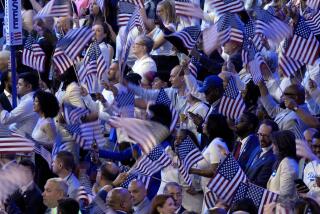Creating Coherence From 64 Design Elements
- Share via
I fly the American flag from a pole in front of my house every day of the year. It has become a sort of neighborhood landmark. Down at the corner market, neighbors refer to my house as, “the one with the flag.”
Flying the flag every day can be confounding to some people. They wonder if there is a national holiday they have forgotten, or if a national figure has died. Or they may think, “Uh-oh, whoever lives there may be some kind of nut.”
Who can blame them? Thanks to various oddball survivalists, and others of that ilk, a fine line has been drawn between patriotism and craziness. Crackpots, it seems, like to have a flag around.
But the truth is, I just like my flag.
Getting the right flag is important. I am careful to make certain that the 50 white stars were embroidered, not printed, on the canton--as the deep blue field is called. The material has to be just the right weight to withstand years of outdoor use and still light enough to wave with a snap in the breeze.
Aesthetically, the U.S. flag is deceptively simple. But it is actually a complicated design problem. A lot of thought went into it.
Vexillogists (yes, they have a name for people who study the history of flags) aren’t certain who designed the American flag. I grew up believing it was Betsy Ross, but historical evidence indicates it was probably Francis Hopkinson, a musician and signer of the Declaration of Independence. Legend tells us that Ross, an upholsterer, sewed the first one. All the elements of my flag have been individually stitched together. Looking at it, as someone having no skill with a needle and thread, I find Ross’ accomplishment a magnificent feat.
Our flag today contains 13 stripes, in two alternating colors, and a panel of a third color containing 50 stars. That’s 64 design elements that must work together at the size of a postage stamp as well as at the size of a football field.
Originally, the idea was to have one star and one stripe for each state. That wasn’t a problem with 13 states. But as states were added, things got a bit sticky. Any first-year design student can tell you that had we adhered to the one star-one stripe policy, the flag today would have 50 very thin stripes--creating an odd seersucker pattern. From any distance, say from the ground to the top of a flagpole, the stripes would appear as a pink area.
At the end of the 1700s, our flag had 15 stars and 15 stripes. In the early 19th century, after Francis Scott Key had written “The Star-Spangled Banner,” Congress, looking down the barrel of 20 states, decided to go back to the original 13 stripes and--in typical bureaucratic compromise--agreed to continue adding stars, one by one, as states were added to the union. We had our chance back then to return to the original 13 stars, but we didn’t--and now there’s no going back. Flag designing is serious business, these things have to last a long, long time.
Design-wise, the addition of stars is problematic. These days, the stars are nicely broken into nine alternating rows of six and five stars apiece. An additional state is, graphically, out of the question. Where would we put that extra star?
To keep the balance, our options are limited. We could add two more states and alternate eight rows with six and seven stars. This is still less balanced than our flag now--which starts with six stars and ends with six stars; the same way that the stripes start with red and end with red, making good design sense.
If we added four more states, we could end up with nine rows of six stars each. The look would be different, however, because the stars would appear in columns as well as rows, as opposed to the checkerboard effect we now have.
If we took the easy route, and added 11 new states, keeping our five-and-six pattern, we’d still have trouble because the canton would become deeper while maintaining the same width. Since the bottom of the seventh stripe aligns with the bottom of the blue field, we’d have to make the stripes wider. Then we’d have to make the stripes longer so the whole thing would fit properly into what most flag makers say should be a 3-by-5 area. It’s a mathematical problem worthy of Isaac Newton.
Needless to say, it’s best to just keep things as they are. Abraham Lincoln, who knew a thing or two about flags, agreed with this. In 1861, after the South had succeeded from the Union, he refused to remove any stars from the flag. He knew a good thing when he saw it.
The low point, graphically speaking, in our flag’s history was the 20-star, 13-stripe arrangement that befuddled authorities to the point where no official design could be agreed upon. During this period, 1818-1846, there were three different U.S. flags flying throughout the country. The design protocol seemed to be: “Use the 13 stripes and fit the 20 stars into the canton any way you can.” This goes against the first rule of corporate identity: Use one thing and stick with it.
Even the contrasting color scheme is unusual by design standards. Imagine the horrified look on a decorator’s face if you insisted that your kitchen be painted red, white and blue. Anyone wearing a red, white and blue outfit can rightfully be accused of dressing up like a flag. Patriotism has the color scheme locked up.
Some people don’t share my enthusiasm for the Stars and Stripes. When flag burning became an issue, I was unfazed. To me, as an avid flag-flyer, it was a nonissue. If some misguided individual believes that burning the U.S. flag will make his point, let him go right ahead.
I couldn’t care less if he wants to burn his flag. Just keep him away from mine.
More to Read
The biggest entertainment stories
Get our big stories about Hollywood, film, television, music, arts, culture and more right in your inbox as soon as they publish.
You may occasionally receive promotional content from the Los Angeles Times.










